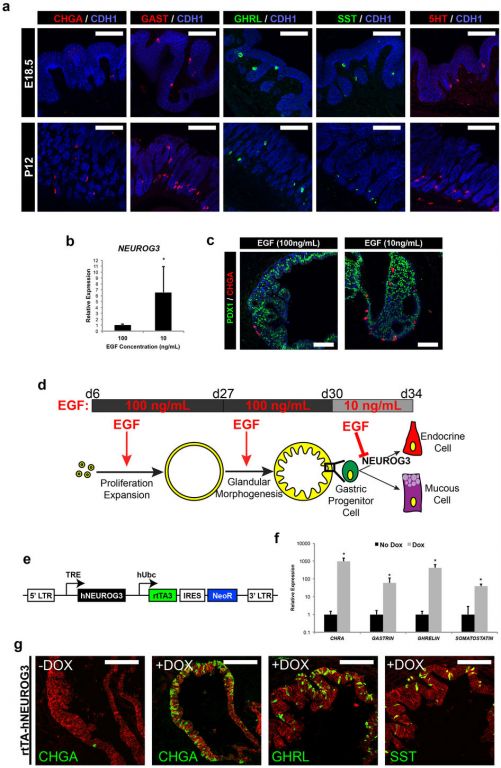博文
科学家在实验室培养出微型人胃
 精选
精选
||
一般情况下,科学家用动物模型研究人类疾病,但是由于胚胎发育和组织结构等种属差异,导致动物模型无法准确模拟人类胃部疾病的真实情况,这也是人类疾病研究中的普遍问题,导致许多动物实验结果无法直接向人类推广应用,甚至许多研究结果完全不适用于人类。人类大约10%患有胃溃疡和胃癌等胃部疾病,这些疾病主要是因为幽门杆曲菌感染导致。同样常规使用的动物模型不能全面反应人类组织器官的真实情况,用人体实验就成为现代医学研究的必须手段,如果科学家能人工培养出各种人类器官和组织,部分需要从人体采集的样本就不再必要,这显然能明显促进人类相关疾病的研究速度和效率。
最近几年,科学家相继成功培养出人类大脑和肝脏等组织,现在科学家又成功培养出人类的胃组织,使用的基本工具是人类的诱导干细胞,通过定向诱导分化,成功获得和正常胃组织结构一样的微型胃。
研究人员通过在不同阶段操作FGF、WNT、BMP、维甲酸和EGF信号通路,使这些干细胞按照一定的空间结构分化形成人胃组织。

这种组织分化的过程在分子和形态上和小鼠胚胎胃组织的过程一致,培养出的组织能形成腺体和绒毛等典型结构,有LGR5阳性细胞、黏膜细胞和各种内分泌细胞,这种培养的胃组织可以作为鉴定新型信号通路的工具,也可以作为疾病模型,如用人幽门杆菌感染可以诱导胃细胞出现特异性c-Met受体分子表达,诱导纤维细胞增殖。
人工培养胃组织将会成为胃部疾病研究的重要研究工具。

Comparison of transcription factor expression between hGO development and in vivo stomach organogenesis. Four embryonic stages (E12.5, E14.5, E16.5 and E18.5) and one postnatal stage (P12) of in vivo antrum development were analysed for expression of the following transcription factors: Sox2, Pdx1, Gata4, Klf5 and FoxF1. The same markers were analysed at two stages (days 13 and 34) of in vitro hGO development and revealed that organoid development parallels that which occurs in vivo. At early stages of antrum development the epithelial marker Sox2 was expressed ubiquitously but at later stages it is downregulated, while other epithelial transcription factors, Pdx1, Gata4 and Klf5, exhibit persistent expression in the epithelium throughout development. Both early- and late-stage hGOs contain FoxF1+ mesenchymal cells surrounding the epithelium, similar to the in vivo antrum. b, Early-stage hGOs exhibit stereotypic epithelial architecture and nuclear behaviour. At day 13, hGOs contained pseudo-stratified epithelia that display apicobasal polarity marked by the apical marker aPKC and the basolateral marker E-cadherin, similar to the E12.5 mouse antrum. Furthermore, extensions of apical membrane (white arrows) were seen within deeper portions of the organoid epithelium. Both the E12.5 mouse antrum and day-7 hGOs appeared to undergo interkinetic nuclear migration, indicated by the presence of mitotic nuclei, phosphohistone H3 (pHH3), in only the apical portions of cells. c, EGF is required for morphogenesis in gastric organoids. Bright-field images demonstrate the requirement for EGF in epithelial morphogenesis including folding and gland formation at late stages of hGO differentiation. When EGF is removed from the growth medium at day 27, before glandular morphogenesis, the hGO epithelium retains a simple, cuboidal structure that fails to form glands. Scale bars, 100 µm (a), 50 μm (b) and 2 mm (c).

Endocrine cell differentiation in the antrum is first evident at E18.5 and highly robust at postnatal stages (P12 shown). As early as E18.5, all expected gastric endocrine subtype hormones are present, including gastrin, ghrelin, somatostatin and serotonin (5-HT). b, High levels of EGF (100 ng ml−1) repressed NEUROG3 expression, however a reduction in EGF concentration (10 ng ml−1) at day 30 resulted in a significant increase in NEUROG3 expression measured at day 34 by qPCR. *P < 0.05; Student’s t-test; n = 5 biological replicates, data representative of 3 independent experiments. c, hGOs maintained in high concentrations of EGF (100 ng ml−1) had very few endocrine cells at day 34, shown by staining for the pan-endocrine marker CHGA. However, a reduction of EGF concentration (to 10 ng ml−1) at day 30 resulted in more physiological numbers of endocrine cells in the gastric epithelium. d, Schematic indicating the effects of EGF at different stages of hGO growth, morphogenesis, and cell type specification. High levels of EGF were required at early developmental stages for growth and morphogenesis, however, it repressed endocrine differentiation at late stages of development; thus, the EGF concentration was reduced at day 30 to allow for endocrine cell development. e, To test whether EGF repression of endocrine differentiation occurs upstream of NEUROG3, hGOs were generated from an ES cell line stably transfected with a dox-inducible NEUROG3-overexpressing transgene. hGOs were maintained in high EGF (100 ng ml−1), then at day 30 were treated with doxycycline (1 μg ml−1) for 24 h and then analysed at day 34. f, g, Dox-treated hGOs show robust activation of endocrine markers CHGA, GAST, GHRL and SST (f), and they contain CHGA-, GHRL- and SST- expressing cells with endocrine morphology (g). *P < 0.05; Student’s t-test; n = 3 biological replicates per condition, data representative of 2 independent experiments. Therefore, NEUROG3 overexpression was sufficient to induce gastric endocrine cell fate in a high-EGF environment. Scale bars, 100 μm. Error bars represent s.d.
https://blog.sciencenet.cn/blog-41174-839744.html
上一篇:科学家将用狗开展抗衰老研究
下一篇:论文引用之惑